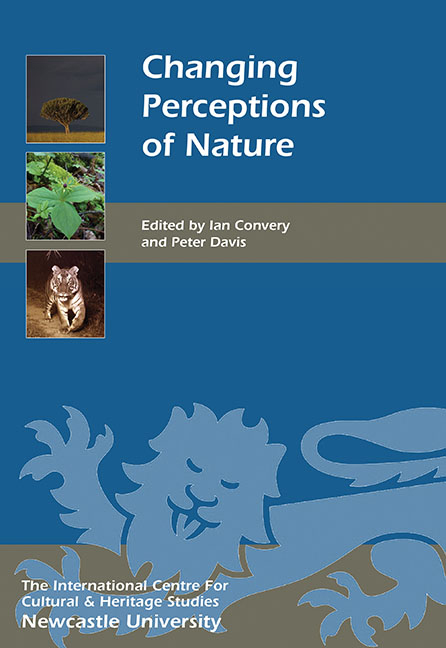Book contents
- Frontmatter
- Contents
- List of Illustrations
- Acknowledgments
- List of Abbreviations
- Foreword
- Introduction
- HISTORICAL PERSPECTIVES ON NATURE
- COLLECTING NATURE
- INTERPRETING NATURE AND LANDSCAPES
- CONSERVING NATURE
- PEOPLE–NATURE INTERACTIONS
- 22 Adventure, Nature and Commodification
- 23 Destination Nature: Wildlife and the Rise of Domestic Ecotourism in Britain, 1880–2015
- 24 Wild Places as Therapeutic Environments
- 25 Citizen Science and the Perception of Nature
- 26 Using Community-based Cultural Tourism to Enhance Nature Conservation in the Rupununi, Guyana
- 27 Representing Natural Heritage in Digital Space: from the National Museum of Natural History to Inuvialuit Living History
- 28 Out of the Wild Wood and into our Beds: the Evolutionary History of Teddy Bears and the Natural Selection of Deadly Cuteness
- 29 Rewilding: the Realisation and Reality of a New Challenge for Nature in the Twenty-first Century
- List of Contributors
- Index
- Miscellaneous Endmatter
29 - Rewilding: the Realisation and Reality of a New Challenge for Nature in the Twenty-first Century
from PEOPLE–NATURE INTERACTIONS
Published online by Cambridge University Press: 26 October 2017
- Frontmatter
- Contents
- List of Illustrations
- Acknowledgments
- List of Abbreviations
- Foreword
- Introduction
- HISTORICAL PERSPECTIVES ON NATURE
- COLLECTING NATURE
- INTERPRETING NATURE AND LANDSCAPES
- CONSERVING NATURE
- PEOPLE–NATURE INTERACTIONS
- 22 Adventure, Nature and Commodification
- 23 Destination Nature: Wildlife and the Rise of Domestic Ecotourism in Britain, 1880–2015
- 24 Wild Places as Therapeutic Environments
- 25 Citizen Science and the Perception of Nature
- 26 Using Community-based Cultural Tourism to Enhance Nature Conservation in the Rupununi, Guyana
- 27 Representing Natural Heritage in Digital Space: from the National Museum of Natural History to Inuvialuit Living History
- 28 Out of the Wild Wood and into our Beds: the Evolutionary History of Teddy Bears and the Natural Selection of Deadly Cuteness
- 29 Rewilding: the Realisation and Reality of a New Challenge for Nature in the Twenty-first Century
- List of Contributors
- Index
- Miscellaneous Endmatter
Summary
INTRODUCTION
The domestication of Earth
Much of this book has considered the history of our changing perceptions of nature. In this final chapter we would like to focus on rewilding: a bold new approach that offers the potential to dramatically change our relationship with nature in the twenty-first century. The ideas for the chapter crystallised during a hike in Cox Scrub Conservation Park, an arid native scrub reserve located on the Fleurieu Peninsula, south of Adelaide in Australia. At only 5.44 km2, the reserve is, by Australian standards, a ‘postage stamp’. It is also quite difficult to observe wildlife in the reserve; only a lone ring-tailed possum sitting atop a tree in the scorching heat provided some indication of life. The surrounding landscape has become largely pastoral, with orchards and wineries now encroaching along the border of the reserve, and filling in former sheep pastures. Wildness has been drawn largely out of the reserve by progressive dewilding; global landscapes, it would seem, are becoming increasingly homogenised.
The coastline between Adelaide and Melbourne must have looked very different back in the early ninteenth century when the English natural historian John Gould was surveying and collecting specimens on the peninsula (see Fig 29.1). Whilst one can imagine the difficulties Gould faced exploring this wild, beautiful but hostile environment, it would be wrong to assume that this landscape was without human influence, though it is likely that the landscape management by Aboriginal communities, who had shaped the landscape for more than 45,000 years, was largely lost on Gould and other early explorers of the Australian continent. Fire management of the vegetation by Aboriginal people was common practice since their ancestors arrived in Australia, with many places managed like an ‘estate’ (following the Aboriginal concept of Country), creating an open woodland landscape (Gammage 2011) with various cultural and ecological practices. The Aboriginals brought about significant ecological changes to Australia, long before the first European explorers set foot on Australian shores (Flannery 1994), not least in terms of hunting megafauna, such as the hippopotamus-sized Diprotodon, to extinction.
- Type
- Chapter
- Information
- Changing Perceptions of Nature , pp. 299 - 316Publisher: Boydell & BrewerPrint publication year: 2016

